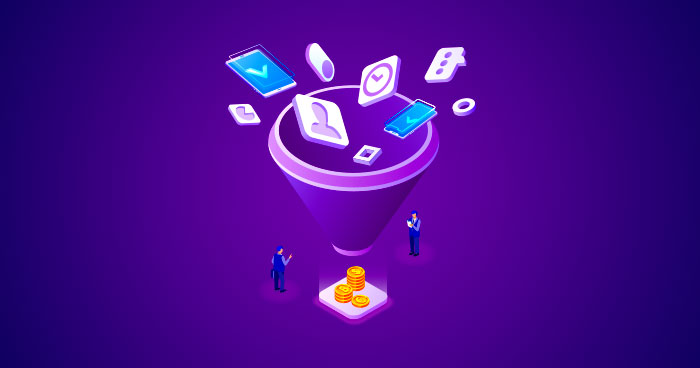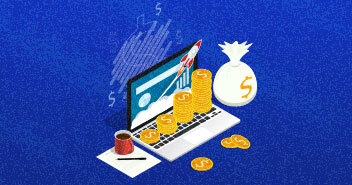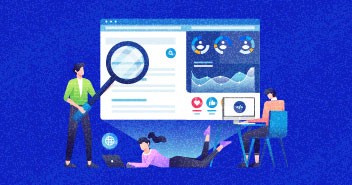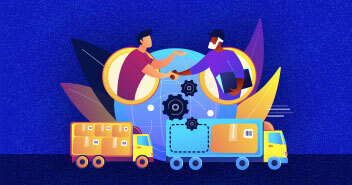
Remember Peddler from Aladdin? Yes, the one that starts off showing his collection of rare and unique clocks. You too can stock up to maximum inventory like him, while walking around with complete peace of mind!
How?
Take your store to the clouds!
Go… online!
Go… ecommerce funnels!
If you already own an ecommerce store, all you would want is to find and sell your products to potential customers, leading you to generate revenue from online sales. Do remember that before the actual sale happens, there is a lot of effort you need to put in behind the scenes.
One of the most important factors that you need to consider is to get your ecommerce funnels ready to help smooth customer journeys for your potential customers.
The question is: what is an ecommerce funnel?
An ecommerce funnel essentially connects the marketing funnel and sales funnel. Let me explain this quickly.
Let’s look at the importance of ecommerce funnels in your business plan. When a potential customer arrives at your website, it’s vital to know their intent and capitalize and at the right opportunity to sell the right product.
To understand this better, let’s look at sales and marketing funnels to understand it’s application.
Types of Funnels: Sales & Marketing
When it comes to ecommerce funnels, there are two major types; ecommerce marketing funnels and ecommerce sales funnels. Though there can be adaptations to these funnels, to better suit the end objective – the basic mode of operation is the same.
Let me explain the difference between the two first.
Defining a Basic Marketing Funnel
Marketing funnels have two end objectives; Lead Generation and Lead Nurturing. In either case, prospective clients get to know your brand or connect with the prospect and build a relationship with that prospect.
Defining a Basic Sales Funnel
The objective of the sales funnel is to pick up prospective customers and convert them to actual customers. While marketing funnels lead to raising awareness and building a relationship with a prospective customer, the sales funnel is what actually pushes the customer to perform a sales-generating action.
You’re no longer wondering why the potential customer left the page of your online store. The marketing/sales funnel will tell you which of the triggers that cost you a potential lead.
- Was it because your potential customer didn’t find what they were looking for on your website?
Or…
- Was it because they had to disrupt the journey and attend another urgent task on their device?
To understand this, let’s take a look at how marketing and sales funnels work together.
How Do Marketing Funnels Work?
Since I’ve already defined the marketing funnel earlier, let’s dive into what a marketing funnel looks like today. Remember that the objectives of sales and marketing are different, the marketing funnel looks essentially the same but has a different end-goal.
Explaining the Stages of Marketing Funnel
Let’s define the stages of the marketing funnel to help understand how it affects the ecommerce conversion funnel.

Figure 1: Marketing Funnel (AIDA)
-
Awareness
This is the initial step leading your visitors to enter the conversion funnel (in this case, the ecommerce funnel). Here you’ll be promoting your business to raise awareness. interest and start building traffic on your website. This will only bring in relevant audiences to your website. Only a small percentage of your audience would be actual potential customers of the product/service you are promoting.
-
Interest
As the number of your website visitors start increasing, you should now be focusing on keeping them interested in your product/service. You can do this by showing multimedia and content that keeps them stuck to your page. You can ask your visitor to sign up for your newsletter so they don’t need to revisit your online business, instead, you can reach out to them. More often than not, website visitors give out their email address in exchange for downloadables, discount coupons, or promotional offers.
-
Desire
Once you’ve built that relationship with your audience you can now start working on high-quality leads, as these are people who have already entered the ecommerce funnel. To move these leads down the funnel, you’ll want to throw in some exciting products and run targeted campaigns to keep engagements with these leads high.
-
Action
Here’s the final and most crucial part of the ecommerce conversion funnel. It’s time to see whether your leads are ready to take a step bigger than micro-conversions (emailers, downloads). It’s time to convert your leads to purchase a product or a service. However, be mindful of the churn rate, as it reflects directly on your lead generation and nurturing stages.
You can already see how the conversion part of this funnel is in the middle (as seen in figure1). The end-goal for this ecommerce marketing funnel is towards building brand loyalty and advocacy. As the marketer of your online store, you would want your quality leads to not only purchase your products, but also become ambassadors of your brand.
Use Cases/Examples
When it comes to marketing funnels, we can look into the sources (on the left side in Figure 1) and use that to understand it’s application. For instance, during the awareness stage of your marketing funnel, you’re likely to pull visitors to your online articles, advertisements, Podcasts, and PPC. The objective here is to generate a lead from your audience pool.
To understand how this works, let’s look at this in perspective of a content marketing funnel.
Application of AIDA: Content Marketing Funnel
In the figure below you can see a content marketing funnel. This comprises three types of content pieces whether it’s top-of-funnel, middle-of-funnel, or bottom-of-funnel. What do these three terms mean?

Figure 1: Marketing Funnel (AIDA)
TOF – Top of funnel content is meant to build awareness of your business so your audience understands your brand and product. Furthermore, content here is more general and it often answers questions that are common or trending in a certain industry.
MOF – Middle of Funnel content brings users to the product page from third party websites and ads. Here visitors look at the range of products/services that are available and suit their interest. Visitors are filtered down to leads that need nurturing. Most often, the sales department handles this situation and understands the needs of this prospective lead.
BOF – Bottom of Funnel content – more often than not – brings visitors to the product pricing page. This is the point where a visitor turns into a quality lead and is ready to make a committed purchase of your product/service.
Real-Life Use Case: ProFlowers
ProFlowers is one company that is doing ecommerce marketing the right way. They have more than 151 types of flowers with classifications of seasons, zones, and images.

Source: ProFlowers
The result?
It generates organic traffic of over 990K which is amazing as just about this is all through their content posts and PPC ads. To relate better, this is a perfect example of TOF content as flowers have a high demand in public, thanks to special occasions.

Source: ahrefs
How do Sales/Conversion Funnels Work?
You’re now probably wondering what an ecommerce conversion funnel does for an ecommerce store? Your potential customer finds a product online and makes a purchase through your ecommerce store. This successful conversion of your new customer depends greatly on how you have designed and placed the conversion funnel,
Explaining the Stages of Sales/Conversion Funnel

Figure 2: Ecommerce sales funnel
We’ve already covered the AIDA part of the funnel, so let’s look at what happens to post the ‘Action’ phase. The next part is ‘conversion’ which means a visitor on your website is now a quality lead.
You’re now in conversation with this quality lead and can now start to add tags pertaining to this entity’s preference.
With the help of analytics tools, you understand the type of products and services this quality lead seeks, and it’s only a matter of time you’ll be able to sell them something they really like.
After the conversion phase, (in the context of ecommerce) is the beginning of the sales funnel. Let’s have a closer look at how an ecommerce sales funnel operates.
Use Cases/ examples
Just like the ecommerce marketing funnel, let’s look at an example of the sales/conversion funnel for an ecommerce store.
Commitment
The first stage is using PPC advertising and pulling visitors to your website. An important aspect of this is to bring in relevant audiences from your audience pool to your website.
The second stage is to build an email list so you’ll incentivize your audience to provide you with their email addresses in exchange for downloadable material. More often than not, you can create content using blog posts that solve certain problems relevant to your audience pool
Now you can zero in on the specific audience who are more than ready to purchase products/services from your ecommerce store.
Sale
As you go down the conversion funnel you realize that your audience pool is shrinking because it’s just a percentage of the audience you are marketing to. Hence, it’s okay just see your audience decrease, as long as your conversion rate stays high.

Figure 3: Sales Funnel
Going back to the ecommerce conversion funnel it’s important to connect with the lead that you acquired through your ecommerce marketing funnel. Furthermore, your aim here should be to convert this lead into a customer that will actively promote your business.
Referring more Quality Leads
If the lead that you have nurtured is right for the product that you’re promoting, there is a high chance that they will add that product to the shopping cart. It’s important to ensure that your shopping cart widget is functioning, it’s what helps you in converting customers.
Now at this stage, your potential customer is ready to make that commitment to purchasing a certain product/service that you are promoting. However, the conversion only completes when the potential customer actually purchases the product increasing your overall sales revenue.
You can refer to figure 3 to understand the sales funnel better.
Real-Life Use Case
One of the best examples of a high conversion rate in sales funnel is Netflix – the movie streaming platform. It uses a simple sign up process, giving users the experience of watching movies for 30 days on a trial.

Notice how Netflix doesn’t give more than necessary information during the sign-up process?
That’s because the sales funnel assumes the quality lead knows what they want and attempts to lead towards the final purchase with minimal steps.

The last stage of this sales funnel explains the different payment plans with their respective features. The company keeps payment gateways subtle in a separate section, showing how the user experience is more important.
The result?
Netflix has a market cap of $163 billion as of March 2020. In fact, it’s become one of the most popular movies streaming sites globally.

Source: Nielson
This is what led Netflix to it’s rapid-fire growth in the last decade. Hence, this shows the effectiveness of a well-designed sales funnel.
Measuring Success of Your Ecommerce Funnel
There are many automation tools available today to help with analyzing post-campaign results. The important part here is to know what metrics to look out for.
For instance,I’m using Metrilo – a tool fit for ecommerce analytics, CRM, and email marketing.

Source: Metrilo
Now, back the question: what KPIs/metrics do you need to look out for? Well. you need to be looking out at the ‘shopping cart conversion rate’ – which explains the number of conversions against the number of carts created.
Here are some more examples of KPIs to look out for:
- Average Order Value
- Shop Cart Abandoned Rate
- Customer Lifetime Value
- Churn Rate
- Revenue Per Click
- Net Promoter Score
For further details about KPIs and metrics, check out our comprehensive article on ecomerce KPIs and metrics to scale your ecommerce store
There is a simple formula to understand how well you are performing in terms of your ecommerce funnel. Don’t worry, if your website visitors drop, as long as you have a consistent conversion rate, your business bottom line shouldn’t be affected.
FAQs – Frequently Asked Questions
1. What is a Conversion Funnel in Ecommerce?
A conversion funnel is simply the illustration of the route taken by a potential customer as they first become aware of your brand, and all the way until they make a purchase. It also consists of various stages including customer retention, upselling, as well as subscription based models.
2. How do I build a sales/ecommerce funnel to drive growth?
When it comes to driving business growth for your ecommerce store it’s important to retain existing customers and attract new ones to extend your current audience pool.
To manage your ecommerce conversion funnel, you need to ensure that your SEO and content strategy are aligned. This way your visitor gets to see the same message from the awareness stage; PPC and the landing page or the final transaction page.
This will ensure your customer journey goes smoothly.
3. Difference between sales and marketing funnel
It’s often very easy to confuse marketing and sales funnels. The marketing funnel is focused on lead generation and leads nurturing, on the other hand, a sales funnel specifically focuses on building sales. Hence, both marketing and sales funnels have different end goals.
Wrapping Up
You’ve now understood how ecommerce funnels work, the difference in marketing and sales funnels, and how they come together when building and growing the audience of an ecommerce store.
The conversion stage works to bring synergy between marketing and sales objectives, which ultimately benefits you in building quality leads and converting relevant leads into customers. This formula works fittingly well as once a customer converts, he/she is likely to recommend your products to their network. You can think of them as ambassadors of your ecommerce business.
If you’re interested, we’ve also written about conversion rate optimization and increasing ecommerce sales on our blog. If you’re still confused about some of the definitions, check our FAQ section above.
Feel free to browse around and if you like something you read, tell us more about it through the comments section below!
Sajjad Shahid
Sajjad is an Ecommerce Community Manager at Cloudways. He loves helping out Ecommerce store owners, merchants and marketers in establishing their businesses and startups. Sajjad enjoys playing table tennis and cricket over the weekend.


